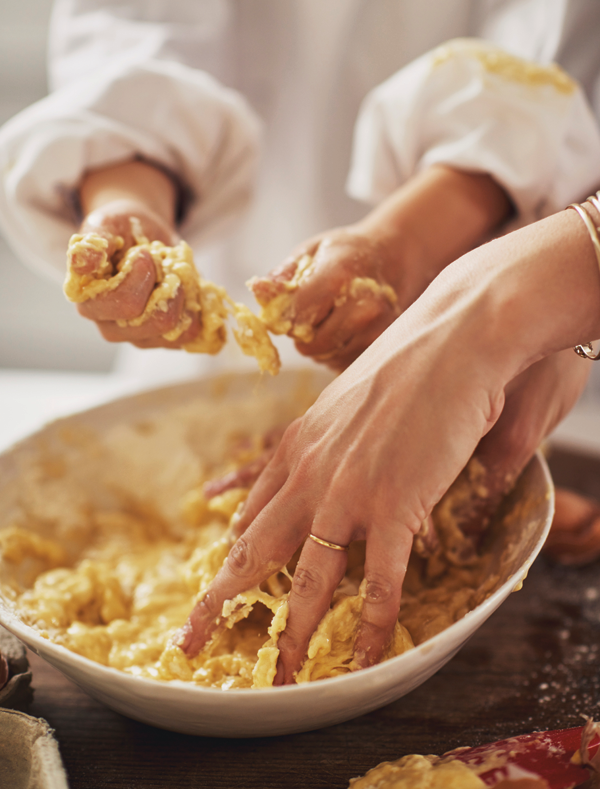We all want to cook-up that perfect bake, but what about making like-for-like dishes that deliver the same taste and quality as non free-from recipes? Vicki Montague from The Free From Fairy looks at some worthy alternatives…
Eggs
- Remove eggs from your diet and you might think you will never have a meringue or cake again. You’d be wrong! There are plenty of ways to substitute eggs in your baking and they are very useful to know when you find you have run out of eggs! Check out the substitutes below.
- Finely ground flax (linseeds) or chia seeds. Mix 1 tbsp with 3 tbsp water to create a gel that will replace 1 egg in recipes that require the egg to bind like biscuits and cakes.
- In sweet recipes try substituting 1 banana or 50g (1¾oz) apple purée for 1 egg.
- In savoury recipes where you need an egg, like in quiche, try using silken tofu. It even works in scrambled ‘eggs’!
- If you want something that you can keep in your cupboard then Ener-G egg replacer can be bought in health food shops. It can be used instead of eggs in most baked goods.
- For the rise that eggs give you in baked products try replacing an egg with 1 tsp bicarbonate of soda and 1 tbsp white or cider vinegar.
- Finally, a fairly new discovery that allows you to make meringues and macaroons egg-free is aquafaba. This is the juice from a tin of chickpeas whisked up until light and fluffy, mimicking egg whites! Use approximately 3 tbsp chickpea (or other bean water) to replace one egg white.
Dairy-free
You may consider baking dairy-free to be impossible, but with a little knowledge you’ll see how simple it is!
- Unsweetened nut milks or other plant milks such as oat milk, soya milk, rice milk (for over 5’s) and hemp milk can be used to replace dairy milk. Nut milks can easily be made in a blender by adding 1 cup of your nut of choice with 2 cups of water.
- Cream can be replaced with cashew cream, made easily by adding about 200g (7oz) cashews that have been soaked for 4 hours to a blender with 115ml (4fl oz) water. You can sweeten slightly if you like, or use it in savoury dishes. Soaked cashews can also be blended to replace cream cheese and cream in a cheesecake.
- Chilled tinned coconut milk can be whipped up and used to replace whipped cream. Again it can be sweetened or flavoured if you desire.
- Mashed avocado can be used to replace butter in recipes in a one-to-one substitution. You may need to add a little more liquid to the recipe to compensate for the lack of moisture in an avocado compared to butter. This also reduces the fat content of the baked goods.
- Coconut butter/cream or coconut oil can be used as a substitute for butter in baked products. Reduce the amount by 20% since it is pure fat, whereas butter is only 80% fat. You may need to add a little more liquid to the recipe.
- Oils, such as olive oil or rapeseed oil can be used in moist cakes such as carrot cake, or in all-in-one cakes where all the ingredients are combined together in one go. Again reduce the amount of fat required in the recipe by 20%.
- Try coconut yoghurt to replace yoghurt. It is very expensive, but a little goes a long way as it is so rich. You can get soya yoghurts too, but be aware that they are very processed and mostly contain sugar (even plain ones).
- Tinned coconut milk can be used to make dairy-free ice-cream.
Sugar-free
- Baking sugar-free can be tricky, but there are ways of avoiding or reducing refined sugar in your bakes. Bear in mind that whatever form of sweetener you use, it is still sugar and is still bad for you! The best advice is just to eat and use less of it, rather than trying to search for a
‘healthy’ sugar. - Try using fruit and vegetables in cakes. They are naturally sweet which means you can considerably reduce the amount of sugar you put in as a sweetener. Be wary of using dried fruits as these have very high levels of sugar.
- There are lots of ‘natural’ sugar alternatives out there with varying attributes; Maple syrup, honey, coconut sugar/nectar, date syrup, stevia, rice malt syrup, rapadura/jiggery/panela and agave. Many can be substituted directly with sugar, while others require a little adjustment.
- If baking with honey, consider that it is hygroscopic, meaning it attracts moisture. This can be a good thing when baking gluten-free, but may make your crisp biscuits not so crisp!
- Reducing the sugar content of a bake by up to 50% will make very little difference to the finished product, but lots of difference to your health (provided you don’t just eat more!).

Gluten-free
So what about baking and cooking without gluten? Gluten is found in wheat, barley and rye and can contaminate oats too as they are often processed in the same place as the gluten-containing grains. However, there are a huge array of grains and starches out there that do not contain gluten and they are becoming far more readily available! Even if you don’t need to avoid gluten, why not widen where you obtain your nutrients from?
A few simple tips will help you obtain perfect bakes:
- When baking gluten-free you need something to replace the elasticity that gluten offers. Xanthan gum is essential in bread recipes, as is extra liquid, so that you have more of a ‘batter’ than a dough. As a rule of thumb, more yeast is required to get bread to rise.
- Up to 1 tbsp ground flax seeds or psyllium husks can be added to retain moisture in gluten-free bakes as they can often be dry.
- Try adding a sugar syrup to cakes once they are cooked and still warm. This helps to bind and add moisture.
- A little gelatine or agar agar can help to add structure to gluten-free bread, as can eggs and pectin.
For more information, visit www.freefromfairy.com

